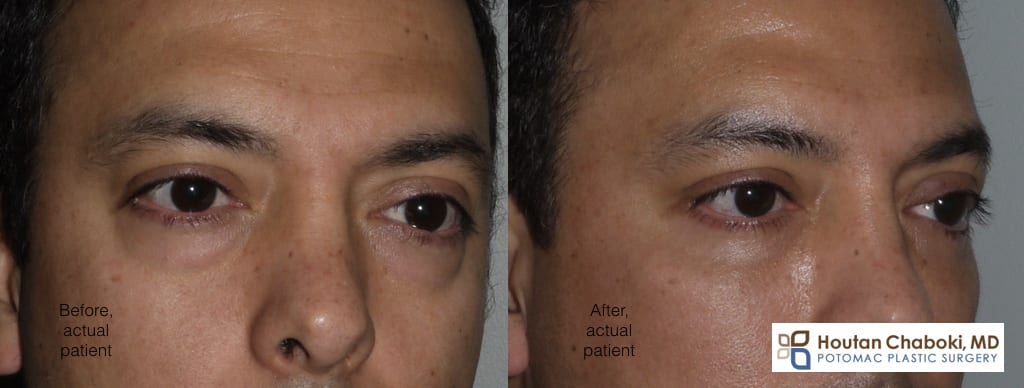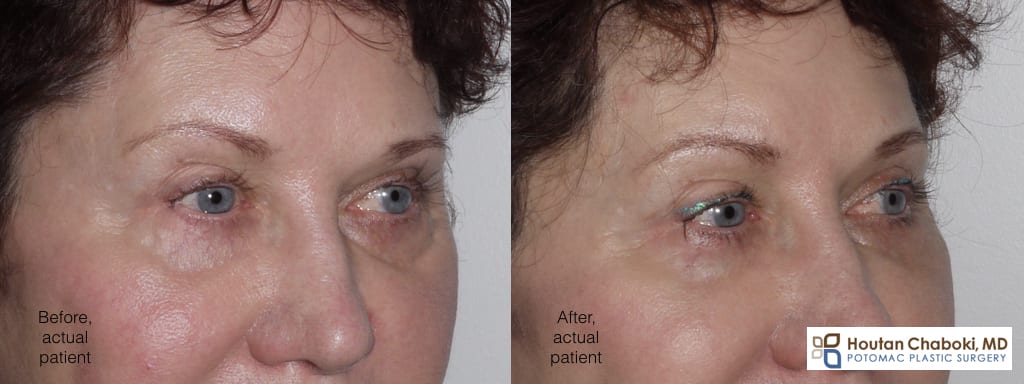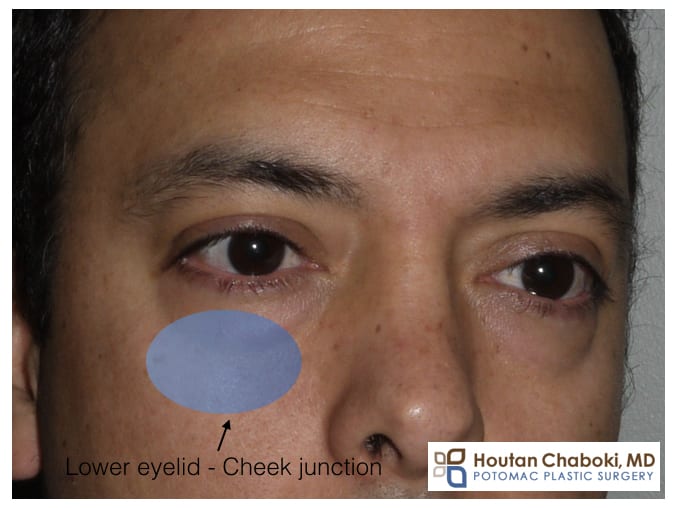The lower eyelid and cheek junction is a commonly treated area by plastic surgeons. This region of the face can start to show the signs of aging before others do. Patients may complain of lower eyelid bags, dark circles, and flat cheeks.
Many terms are used to describe this region of the face, including the tear trough, infraorbital rim, and mid face. For patients, this area can improved with a variety of aesthetic treatments.
The lid-cheek junction is a critical area of aesthetic rejuvenation treated by facial plastic surgeons. – Houtan Chaboki, MD
Lower Eyelid and Cheek junction
The lower eyelid and cheek junction is a broad area bounded by lower eye (superiorly), smile line (inferiorly), and the cheek bone and nose on either side. From a cosmetic standpoint, this region involves all tissue types including skin, muscle, fat, and bone. The lower eyelid and cheek junction should blend with the rest of the face and eyes. Dark circles, bags, wrinkles, and flat cheeks may negatively draw one’s attention to this central area.
Lower eyelid bags develop from a variety of factors:
- Excess fat around the eye itself creating bulges – some are born with relatively excessive eye fat and, therefore, have lower eyelid bags early in life.
- Too little fat in the area beneath or under the eye bag itself – all lose facial fat volume in this area over time.
- Insufficient bone volume – cheek bones shrink and fall with age.
- Loose and wrinkled skin – dermis and epidermis layers of skin become discolored, uneven, and thin.
Tissue atrophy of the skin, fat, and bone is the primary mechanism of age-related visibility of these landmarks. A valley or hollow area develops between the lower eyelid and cheek. Tissue descent of this region is less of a factor. Lastly, bulging fat around the eye accentuates the undesirable appearance.
Treatment of the Lower Eyelid and Cheek Junction
As with many other facial areas, the two main treatment options are nonsurgical and surgical. Regardless of specific treatment, a common goal is to change the relative tissue volume of certain areas to “lift” and rejuvenate. By blending the lower eyelid and cheek junction, the final result is a smoother and more youthful appearance. Patients may start with nonsurgical options, then advance to plastic surgery as appropriate.
Treatment is dependent on an individual’s specific facial anatomy and personal goals. Patients with bulging eye bags may require lower eyelid surgery with eye fat reduction. Those with flat cheek bones can benefit from cheek augmentation with silicone implant. Midfacial depressions can be enhanced with facial fillers as part of a liquid facelift.

Before and after plastic surgery photograph. Lower eyelid surgery with fat transfer was performed to blend the lower eyelid-cheek junction.

Before and after plastic surgery photograph. Restylane® injections was performed to blend the lower eyelid-cheek junction.
What is the best treatment? As with all facial cosmetic surgery, the plastic surgeon will perform an examination and help determine possible options for each patient and help the patient choose the “best” option for them. For those who don’t have the time for recovery, then a non-surgical liquid lift of the cheeks and lower eyelids may be more appropriate. For those who want a permanent change, then lower eyelid surgery (blepharoplasty), fat injections, or cheek implants may be better options.
Questions? Share your thoughts below.


Can hollow lower eye lid and the flat cheek bone be corrected parmanently through surgery and can it be done in Nigeria with the cost implementation
Thank you for reading the blog!
A hollow lower eyelid and flat cheeks can be treated with facial fat transfer, for example. However, plastic surgeons generally don’t consider surgery permanent, as the body continues to change over time. Office consultation is required to help determine appropriate options.
Best,